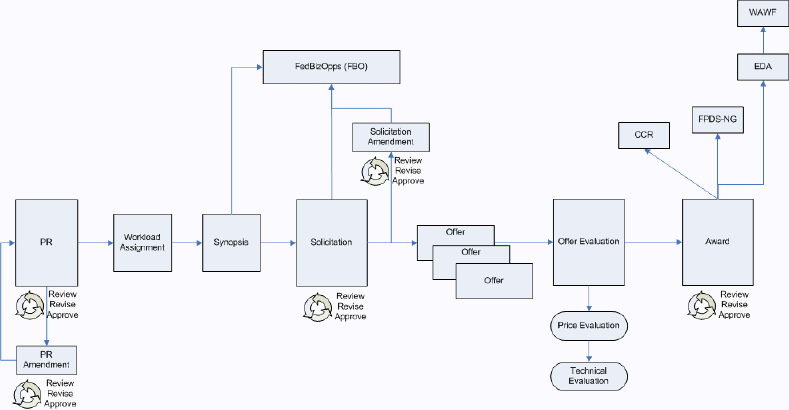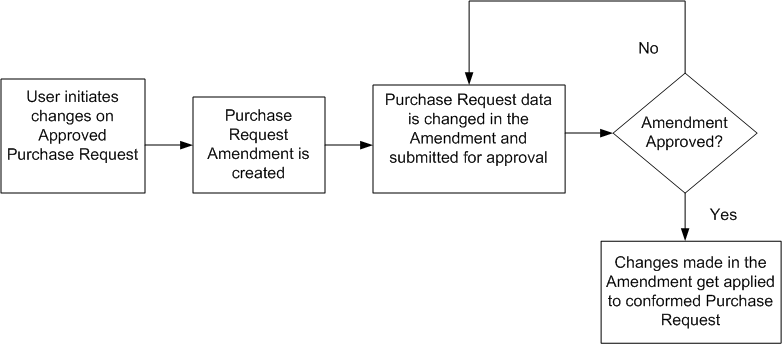Key Concepts: Public Sector Procurement
Overview of Oracle Contract Lifecycle Management for Public Sector
Oracle Contract Lifecycle Management (CLM) for Public Sector is a comprehensive solution for managing procurement processes that are performed by federal agencies. CLM features are available in OA Framework HTML pages. CLM supports FAR, DFARS, and other agency regulations that define the federal business processes, and encompasses a full procure-to-pay process flow within Oracle e-Business Suite which maximizes benefits to federal users. CLM enables contracting officers to drive operational excellence in federal procurement functions and enables the agencies to cut procurement costs dramatically. By providing the end-to-end business intelligence with a single source of data, CLM provides data transparency and visibility and provides contracting officers with support for strategic planning and improved decision making.
The following process flow depicts the procurement lifecycle in CLM:
Contract Lifecycle Management

The flow starts with the creation of a purchase requisition which is a document that represents a requirement or demand for supplies and services. This is associated to an Acquisition Plan that outlines the procurement plan on a larger scale. The purchase requisition is converted to a solicitation and the solicitation is sent out to vendors for obtaining their quotes/offers. When the offers are received from the vendors, they are evaluated and the contract is awarded to one of the vendors.
This process depicts all of the major procurement steps from purchase request initiation and commitment, through competitive solicitation with an offer evaluation phase, and ultimate award decision. The process is often not executed in its entirety – several steps are optional and at the discretion of the contracting officer depending on the procurement. Some steps may be required by an agency in order to follow it's policies and regulations, but from a system’s perspective, the steps can be executed without every procurement document in the chain.
Document Numbering
You can create a configurable, intelligent numbering format for CLM documents that follow Federal Acquisition Regulations (FAR) and Defence Federal Acquisition Regulations (DFARs) processes. Based on your configuration and setup of the numbering structure, a document number is defaulted automatically on the CLM documents. You can modify the defaulted document number as long as the document is in draft mode.
For more information on the document numbering guidelines, please refer to the appendix - Common CLM Functionality.
Note: To set up the document numbering structure for use in CLM documents, please refer to the Oracle Contract Lifecycle Management for Public Sector Implementation Guide.
Contract Line / Sub-Line (CLIN / SLIN)
The Contract Line (CLIN) and Sub-line (SLIN) structure is used in all CLM documents, including modifications and amendments to the purchasing documents. A Contract Line captures information about the item(s) or service(s) to be procured in the contract with or without the pricing details. Thus, a Contract Line (CLIN) can be a priced line or an informational line. Similarly, Sub-Lines, which are used to capture additional information about the CLIN, can be priced sub-lines or informational sub-lines.
When a line is added to a CLM document, it is numbered automatically according to the line numbering setup that follows federal government regulations. This provides a flexible way to configure line numbering. In the CLM document, you can specify if the line should be priced or informational, as well as organize them into a complex line and sub-line structure, in accordance with federal regulations.
For more information on CLIN/SLIN, please refer to the appendix - Common CLM Functionality.
Acquisition Plan
An Acquisition Plan is created and used by a federal agency to outline the proposed requirements and acquisitions of the agency. The Acquisition Plan ensures that the agency fulfills it’s procurement requirements in a timely and cost-effective manner.
CLM addresses the frequently used (but non-standardized) need across federal agencies to coordinate and plan acquisition efforts. You can perform a combination of actions within the Acquisition Plan Summary, including capturing information related to procurement purpose, solicitation method, extent of competition, potential vendors, supporting attachments in multiple formats and other key data elements associated with typical procurement activities. The Acquisition Plan Summary is routed through an approval chain before it gets finalized. Another important feature of the Acquisition Plan is the ability to reference the Acquisition Plan Summary in Purchase Requisition and Solicitation documents. The Acquisition Plan Summary is referenced at the header level of these documents. You can also print the Acquisition Plan Summary as a draft or finalized copy.
For more information on Acquisition Plan, please refer to My Oracle Support.
Options
You can choose to create an option line on a requisition that you intend to exercise as a regular line at a future point in time. For example, a software purchase can be entered as a base line. This necessarily entails support and training as options for the purchase of a software package. Therefore support and training can be entered as option lines if the buying organization intends to procure them at a later point of time. At a later date, the options of support and training can be exercised as regular purchase order lines. The option lines of support and training, once exercised, can be received and invoiced as well.
This capability in CLM enables the contracting professional to mark lines as Option lines – lines which can be exercised later via a modification to the award if desired. Option lines can be associated with base lines and often involve follow-on work. Option lines behave similarly to CLINs/SLINs except they are not funded until exercised after the awarding of the contract.
A CLIN or SLIN can be further defined as an Option Line. An Option Line stores and displays information that is used at a future point in time.
For more information on Options, please refer to the appendix - Key CLM Functionality.
Pricing
Using CLM, contracting professionals are able to price Requisitions, Awards, Orders, IDVs and Modifications by specifying federal Contract Types such as Firm Fixed Price, Cost plus Award Fee, Time & Materials, Cost Sharing, etc. The Contract Types form the basis for determining the price payable to a vendor. Prices are manually entered by the user or are defaulted on the purchasing document line depending on the item/supplies/service setup. The final price calculation depends on a number of factors: Contract Type, Cost Constraint, price of the item/service.
The CLIN or SLIN can be a Priced or Informational line. For pricing calculations to take place, the line should be defined as a Priced Line, and not an Informational Line.
Lines can be Quantity Based or Amount Based. A Quantity Based Line Type enables you to enter information for goods/supplies. An Amount Based Line Type enables you to enter pricing information about services. Different Contract Types display based on the line type you select.
The Contract Type is available on the lines of a Purchase Requisition, an Award, IDV or a Solicitation. The Contract Type may be changed by the user depending on business requirements.
The IDC Type field displays for Solicitation documents (where the outcome document is an IDV) and IDVs on the line details page.
For more information on Pricing, please refer to the appendix - Common CLM Functionality.
Incremental Funding
CLM enables you to provide funding information for a Requisition or Award / Order. You can create and approve Requisitions, Awards and Orders with no funding or with partially available funds. You can incrementally fund the Award / Order lines through the Modification feature, depending upon the availability of funds. Additionally, you can add funds to an existing distribution or add new distribution(s) to existing line.
Due to system-enforced rules, you cannot receive and pay beyond the funded line amount thereby ensuring that the obligation cannot be more than the funds available.
Contract Funding guidelines are outlined in the FAR site. You can reserve funds for a Purchase Requisition or Award line and ensure that the line amount is equal to or less than the reserved or encumbered amount. Enter the funded value on purchasing documents such as Purchase Requisitions and Awards. You can reserve funds as Null, partially or fully, i.e., the funded amount can be less than the line amount. You can modify these documents without having to liquidate the existing funds on the documents.
Note: IDVs will not have the funded value field, i.e. IDVs cannot be encumbered.
For more information on Funding, please refer to the appendix - Common CLM Functionality.
Purchase Requisition Amendment
Requesters can make changes to approved requisitions via requisition amendments as is sometimes required in the procurement cycle. The requester can create a requisition amendment after requisition lines have been approved, solicited, offers have been received, and a draft award has been created. Changes in the requisition amendment serve varied purposes, such as, changing line item information, adding funds to partially funded lines, adding new lines for goods and services or cancelling existing lines. Line changes in requisition amendments are made available to contracting professionals and they can implement the changes in the Solicitation or Award documents. Additionally, you can see a history of all the amendments made to a requisition and can also compare changes made through a specific amendment on the conformed requisition.
Purchase Requisition Amendment

For more information on Purchase Requisition Amendments, please refer to the chapter Requisition Amendments.